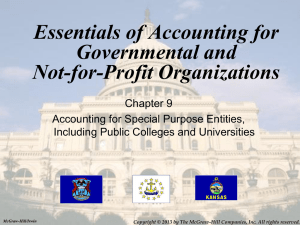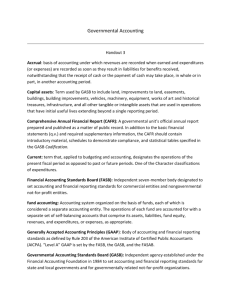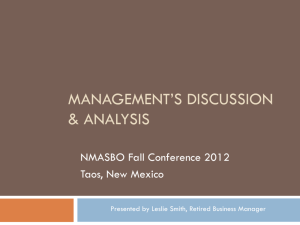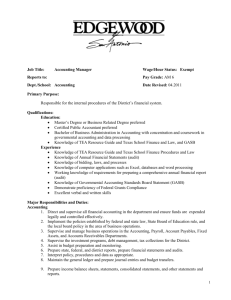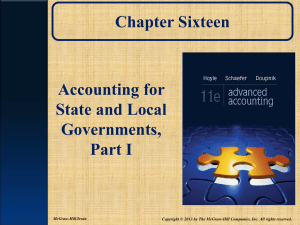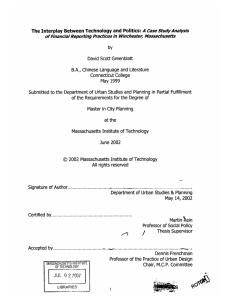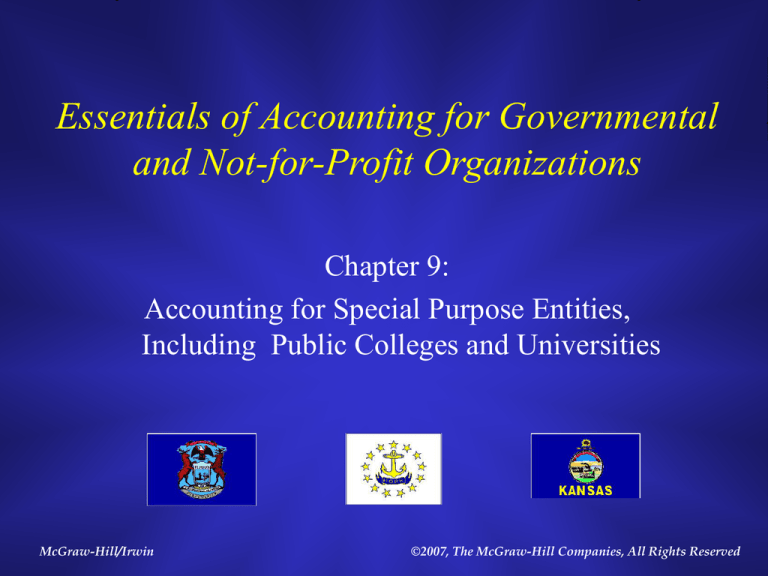
Essentials of Accounting for Governmental
and Not-for-Profit Organizations
Chapter 9:
Accounting for Special Purpose Entities,
Including Public Colleges and Universities
McGraw-Hill/Irwin
©2007, The McGraw-Hill Companies, All Rights Reserved
9-2
Special Purpose Entities
• General Purpose
Governments
include: States,
counties, cities, towns,
and villages.
• Special Purpose
Entities include: Fire
protection districts,
park districts, and
public authorities.
• A SPE may be a
component unit of a
General Purpose
government.
9-3
Special Purpose Entity Reporting
• If engaged in governmental and business type
activities
– Use general GASB 34 reporting model and report
both fund basis and government-wide financial
statements
• If engaged in multiple governmental activities
– Use general GASB 34 model, just omit enterprise
funds statements which are not applicable
9-4
Special Purpose Entity Reporting
• If engaged in single governmental activity
– Can prepare governmental fund, government-wide
statements, and reconciliation effects all on one
statement
• If engaged only in business-type activities
– Can prepare enterprise fund financial statements (no
need for government-wide)
• If engaged only in fiduciary type activities
– Can prepare fiduciary fund financial statements
9-5
PUBLIC Colleges and
Universities
• Public College financial reporting is
covered by GASB.
• Private Colleges come under FASB
guidance -- covered in chapter 11.
• Although there are more private than
public colleges, roughly 3/4 of the
students attend public institutions.
9-6
Public College
Financial Reports
• Public Colleges may have governmental
type activities, business type activities, or
both.
• Most public colleges, with the exception of
some community colleges that have power
to levy property taxes, will report as
governmental units with “business activities
only”.
– Therefore they will prepare enterprise fund statements
9-7
Public Colleges and Universities
– GASB 35
– GASB 35 requires statements similar to those of
special purpose governments under GASB 34.
– The effect is to require colleges to use the accrual
basis and record long-term assets, including
infrastructure, along with depreciation.
9-8
Public College
Statement of Net Assets
• Assets and Liabilities
– Classified as current and noncurrent.
• Net Assets Classified as
• 1) Invested in capital assets, net of debt,
• 2) Restricted -- Nonexpendable and Expendable
• 3) Unrestricted
• Note: Deficits in unrestricted assets may be
common because
– Colleges are not accustomed to setting aside funds
for depreciation.
– States seldom fund compensated absences in
advance.
9-9
Public College Statement of Revenues,
Expenses and Changes in Net Assets
• Operating Revenues:
– Student Tuition net of scholarship allowances
– Federal and State Grants
– Auxiliary
• - Operating Expenses including depreciation
• + or - Nonoperating Revenues and Expenses
– Includes state appropriations, gifts, investment income, interest
on capital debt
• + or - Capital appropriations, gift, endowment
additions
• = Increase in net assets
• + Beginning net assets
• = Ending net assets
9-10
Public College Statement of
Cash Flows
• Must be on direct format
• Operating: Excludes interest and dividend revenues and
expenses
• Noncapital Financing: Includes state appropriations and gifts
including endowments
• Capital Financing: Purchase of long-term assets and related
gifts, appropriations and debt repayment including interest
• Investing: Includes interest revenues, endowment and other
investments kept separate
• Reconciliation of Operating income to cash flows from
operations
• Could also have noncash financing and investing section

